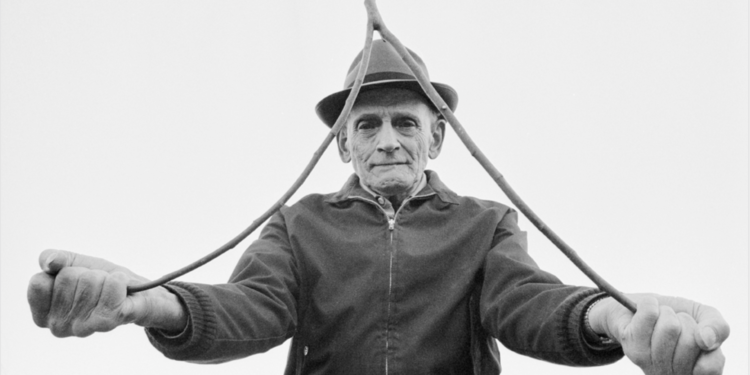THE AGE-OLD ART OF DOWSING OR WATER-WITCHING

The ancient Egyptians etched water-diviners on the walls of their temples. The Bible alludes to Moses dowsing for water. The Roman general Gaius Julius Caesar took dowsers into the deserts of Africa to find water for his troops. Cleopatra, a queen of Egypt, had five dowsers on her barges who used silken cords with a gold-nugget pendulum. This ancient art of dowsing, or water-witching, is basically the popular practice of using a Y-shaped twig cut from a tree, called the ‘divining rod’, to locate underground sources of water on farmlands and arid regions. Paintings in North African caves dating back 30,000 years show a prehistoric man with a rod in his hand. But, the term ‘dowsing’ refers not only to divine streams of water but also to find veins of ore, gemstones, oil, lost objects, missing people and claimed radiation. The divining rod is also used to solve crimes, diagnose illnesses, locate enemy mines in wartime, find breaks in pipes, etc. Yet, scientists assert that dowsing, which does not resort to a scientific device, is no more effective than random chance and hence, it is classified as a pseudoscience.
Sir William Fletcher Barrett (1844-1925), an English physicist and parapsychologist who authored Psychical Research in 1911, quoted a biography of St. Teresa of Spain which narrated how she was offered a site in 1568 for a convent where there was no water supply. But, a friar named Antonio willingly came up with a twig in his hand, stopped at a certain spot, made a movement with his twig and asked to dig there, whereupon an abundant fount of water gushed forth, ideal for both drinking and washing, which never ran dry. The biographer believed this to be the first historical reference to dowsing for water and remarked that the saint, not having heard of dowsing before, had no explanation for this event and regarded it as a miracle.
But, the Catholic Church, however, banned the practice completely. Martin Luther (1483-1546), a German priest and theologian, perpetuated the ban, issuing a proclamation in 1518, listing the use of the rod to divine metals as an act that broke the First Commandment. Luther was the seminal figure of the Protestant Reformation whose followers came to be known as Lutherans.
1n 1662, divining with rods was ascribed to the work of the Devil by Gaspar Schott (1608-1666), a German Jesuit and scientist, although he later doubted the involvement of the devil in the movement of the rod. There were elaborate church rituals to avoid contamination by it. In the 17th century, in southern France, the rod was used for tracking criminals and heretics, but in 1701 the Inquisition, an institution to combat heresy within the Church and conduct trials against the accused, decreed that the rod could not be used in criminal prosecution. Although dowsers or hydroscopes (another name given to those who react strongly in the presence of water) were frowned upon by religious authorities, some of the best ones were Jesuit priests and ministers, namely, the Abbé Gabriel Lambert who looked for water with a bobbin made of cork and suspended from a thread; the Abbé Paramelle, who found 10,275 sources of water in 25 years, most of them at depths of more than 15 m; the Abbé Bouly; and many more.
The dowser walks over the property, holding the twig with both hands close to his chest until it begins to revolve or dip towards the ground. This movement indicates that he is near or directly over a hidden vein of water. In certain cases, some rods have made as many as eighty revolutions a minute. What makes the rod turn? No one knows for certain, but one theory is that unconscious or involuntary muscular movements act upon the rod, and when the dowser grasps it more tightly to prevent it from turning, conflicting sets of muscles create the strong movement. Another theory posits an electromagnetic field that acts upon the rod in the presence of earth and water. Others claim that dowsers respond to radio waves and they are affected by radiations from the earth. All these theories, in general, may be partially true, but they do not explain dowsing at a distance. That is why some parapsychologists are of the view that clairvoyance (the psychic ability to see persons, things or events clearly that are distant in time or space) seems to play a large part in the dowser’s success.
It has been observed that the rod does not move over stagnant water and the water must be in motion for the rod to work. When the French dowser Abbé Lambert walked over hidden springs, the bobbin he used instead of the rod, would spin wildly in widening circles.
No chemical action has been discovered that would operate from the water to the rod. Almost any kind of wood works in the rod, but maple or hazelwood is highly recommended by dowsers. What is more important is not the kind of wood, but the weight, symmetry and balance of the rod. There have been rods made of wire, whale-bone and nylon. Dowsers have used pliers, crowbars, horseshoes, even a rubber ball suspended from a string. One woman dowser held a hairpin.
Power companies and water-supply firms call in dowsers to locate breaks in pipes while railroad companies and breweries have had dowsers on their payroll.
The famous British dowser John Mullins said he felt an electric shock and his arms ached all night after he found the water. Others feel a tingling sensation, are chilled or nauseated, and sometimes faint. Still others spit blood and begin to wheeze when they are near water. Bleton, a famous 17th century hydroscope, had convulsions whenever he walked over the running water while a Marseilles hydroscope, Jean-Jacques Parangue, was filled with horror whenever he approached unseen water. Many dowsers are unable to sleep if a water pipe is located under their bedroom.
Sometimes the dowser can transfer his ability to another person merely by touching him or holding his wrists. In a Russian experiment, it was found that when a sceptic touched a dowser, the rod refused to turn. The Russians equally claimed that lightning storms inhibit dowsing. In many cases a silken or woolen glove, rubber-soled shoes, or a tight bandage on the arm or leg of the dowser have hampered dowsing.
Divining rod to dowse metals and oil
During the Middle Ages in Germany the divining rod was used to dowse metals and a manuscript of 1430 indicated how the rod was used to find ore. The dowsing was recommended as a practical help in mining. The mining technique was brought over to England in the 17th century, where it was practised in Cornwall. Some miners bent metal clothes-hangers into L shapes and held one in each hand pointing forward as they dowsed. The hangers swung wide when they were over metals in the ground.
One of the best-known dowsers, Evelyn Penrose of England, was once employed by the government of British Columbia to locate oil through dowsing and she found 12 wells this way.
Map-dowsing
To dowse for water or metals over a map of the property, the map must be fairly large and detailed. In one instance reported by writer Beverley Nicholas, Penrose dowsed a map of a South African mining area while she was in a living room in England. Henry Gross, the New England dowser, found a well site in Bermuda while he was looking at a map in the U. S. state of Maine. Ray Willey of the American Society of Dowsers (ASD) used a road map and once he found water in Point Roberts, Washington, while he was in Schenectady, New York, more than 4500 km away. A fisherman once asked map-dowser John Shelley to pinpoint a good source for lobsters. Using a large map of the Maine coast, Shelley located a better area farther north where the fisherman pulled in a fine catch of lobsters.
Lost coins, jewellery and other valuables have all been found through dowsing. In India a dowser finds lost or stolen objects by holding two bamboo rods. When the object is near, the rods cross horizontally, then alternatively rise and descend. Jacques Aymar-Vernay, a French peasant, who lived in the 17th century, was frequently employed by the French police to trace criminals. It was reported that Aymar once located the murderers of a wine merchant and his wife by following the path of the killers over land and sea.
Divining rod on the battlefield and for medical diagnosis
Marine engineers in Vietnam used coat-hangers as rods to locate enemy tunnels, mines and buried rifles. A French veterinarian has reportedly used a pendulum to diagnose an animal’s illness. Another prop, a rodlike device invented by psychic Verne Cameron of California, called ‘aurameter’, is passed over the patient’s body and when it reaches a trouble or weak spot it begins to turn. It was even said that a French dowser named Bossuet could predict the sex of eggs.
Dowsing animals and plants
Animals are natural dowsers which do not need divining rods. Dogs have been used to dowse mines in Vietnam. People living in deserts of Mexico depend upon their donkeys to find water. Among the best animal dowsers are donkeys, horses and armadillos. These animals dig down until their bodies and faces are almost completely covered, and they never stop until the water appears.
But the most natural dowsers of all life forms are the plants. A plant depends upon water for its life. There is an oak tree with a 42-metre-long root that wanders horizontally underground in search of water.
Dowsers vs geologists
The geologist relies on his knowledge of the terrain and surface features that may indicate the presence of underground water whereas the dowser depends upon his twig or rod to locate it. Dowsers have succeeded in finding water after the geologists failed. Some experiments pointed out that the geologists found the general location of the water site, but the dowsers went to the exact spot. Many geologists, engineers and other trained scientists are now enthusiastic dowsers in their own right. They regard the rod as another detection tool along with their Geiger counters and magnetometers.
Greg Storozuk, the one-time ASD president, claims that it is not the rods that are attracted to the water, but the mind does the work, and the tool just does the indicating. He regrets that science has no answers and therefore the skill gets swept under the rug, relegated to the province of “folklore and magic”.
Dismissed as pseudoscience
British psychologist David Francis Marks (born in 1945) says that dowsing is not a paranormal phenomenon but can now be explained by orthodox science. According to him, specifically, dowsing could be explained in terms of sensory cues, expectancy effects and probability. American archaeologist Kenneth Feder (born in 1952) says that many archaeologists do not use dowsing, because they do not believe it works. British psychologist Christopher Charles French (born in 1956) notes that dowsing does not work when it is tested under properly controlled conditions. American science writer Peter Daempfle (born in 1970) is also of the same opinion that dowsing fails when it is subjected to scientific testing. He says that although some dowsers claim success, this can be attributed to the underground water table being distributed relatively uniformly in certain areas. A U. S. Geological Survey also suggests that dowsing is not a surprising ability, as some water exists under the Earth’s surface almost everywhere.
But that does not explain what makes the rods move! ***







